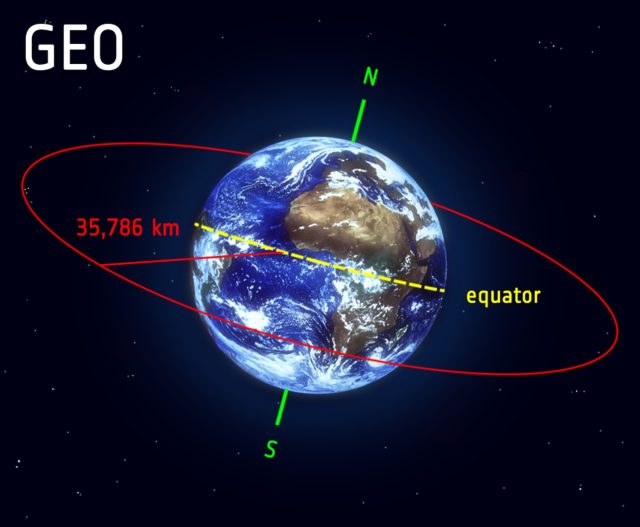8:45 pm EDT update: The launch of an Atlas V rocket with the Silent Barker mission has been postponed from Tuesday due to Tropical Storm Idalia. “Out of an abundance of caution for personnel safety, a critical national security payload and the approaching Tropical Storm Idalia, the team made the decision to return the rocket and payload to the vertical integration facility (VIF),” ULA said. “We will work with our customers and the range to confirm our next launch attempt and a new date will be provided once it is safe to launch.”
Original post: The National Reconnaissance Office doesn’t typically talk about any of its missions, but in an unusual break with precedent, the button-down spy satellite agency is taking a different tack with its next launch Tuesday from Cape Canaveral, Florida.
“We’re trying to be more transparent and share more information,” said Chris Scolese, director of the National Reconnaissance Office, in a roundtable with reporters Monday. As more countries and companies launch missions into space, Scolese said the space environment is becoming more congested, contested, and competitive.
“It’s also becoming easier and easier to see what’s going up there,” Scolese said. “We want to let people know, to some extent, what our capabilities are.”
The NRO has multiple satellites—officials won’t say exactly how many—mounted on top of a United Launch Alliance Atlas V rocket for liftoff at 8:34 am EDT (12:34 UTC) from Cape Canaveral Space Force Station. Their destination is geosynchronous orbit, a belt of satellites positioned more than 22,000 miles (nearly 36,000 kilometers) over the equator.
In geosynchronous orbit, a spacecraft completes one lap around Earth at the same rate as the planet’s rotation, giving a satellite a constant view of the same geographic region. That makes geosynchronous orbit a popular location for communications satellites, weather observatories, and platforms to detect the first sign of a missile attack.
The US Space Force and the NRO have numerous satellites in geosynchronous orbit, and the mission poised for liftoff Tuesday will help track potential threats to those multibillion-dollar assets.
“Geosynchronous orbit is far away,” Scolese said. “Ground-based systems have a harder time seeing what’s up there. This provides us the capability of being in this same orbit, so that we’re closer to what’s happening up there. It will not be looking at the ground, it will be looking at space.”
You can watch Tuesday’s launch on ULA’s live webcast, which we have embedded on this page.
Bark or bite?
This new mission also has a snappy code name—Silent Barker—and an eye-catching mission patch, which isn’t unusual for launches with NRO spy satellites.
The NRO and the Space Force are partners on the Silent Barker mission. The NRO managed the development of the satellites and will operate them once they’re in orbit, while the Space Force is providing the launch on ULA’s Atlas V rocket.
The Silent Barker satellites will detect and continually track other objects in geosynchronous orbit, a capability that military leaders have prioritized over the last decade. In that time, Pentagon officials say there has been an escalation in “cat and mouse” games between US satellites and those operated by China and Russia.
US officials have highlighted several occurrences of Russian inspector satellites approaching US spy satellites flying in low-Earth orbit in recent years. Higher up in geosynchronous orbit, another mysterious Russian military satellite has roamed near numerous commercial communications satellites and a French-Italian military spacecraft, raising concerns that it may be trying to intercept radio signals.
The US military already has its own satellites capable of approaching other objects in geosynchronous orbit. These satellites, part of the Space Force’s Geosynchronous Space Situational Awareness Program (GSSAP) program, were part of an orbital dance with two Chinese military satellites last year.
The US military dispatched one of the GSSAP satellites to get a closer look at the two Chinese spacecraft, but the Chinese satellites took off in opposite directions. Then one of the Chinese spacecraft settled into a position to get a sunlit view of the Space Force surveillance satellite that had been chasing it.
So far, there haven’t been reports that any of these cat-and-mouse games have resulted in a physical or cyberattack on a US military satellite, but that’s what the Silent Barker mission is designed to guard against.

“The idea of the mission is to put a satellite into geosynchronous orbit and then to be looking at that orbital regime and get a sense of what’s happening day to day,” Scolese said. “Satellites do move in geosynchronous orbit. You’ve heard about communications satellites moving from one location to another to provide better coverage to other areas.”
Officials have not disclosed what companies were involved in building the Silent Barker satellites or what kind of sensors the spacecraft will use. The budget for the program also remains a secret.
“Certainly, we want to be able to see that so we know what’s going on in the area, but we also want to know if something is going on that is unexpected, or shouldn’t be going on, that could potentially represent a threat to a high-value asset, either our’s or one of our allies,” Scolese said.
He called the Silent Barker mission a “watchdog” in geosynchronous orbit. That’s similar nomenclature to the “neighborhood watch” description the Space Force has used for the GSSAP satellites. A key difference between the Silent Barker and GSSAP programs, according to military officials, is the ability of the Silent Barker satellites to continually monitor the position, or “maintain custody,” of other objects in geosynchronous orbit.
“What Silent Barker is going to do is provide that indication and warning (of a possible threat to a US satellite), so it can inform decisions about what we do or don’t need to do in terms of maneuvers or awareness,” Scolese said.
“The capability that we’re going launch tomorrow goes a long way to giving us competitive endurance and competitive advantage in space to make sure we not only see, but maintain custody of the threats in GEO (geosynchronous orbit),” said Lt. Gen. Michael Guetlein, who heads US Space Systems Command, which oversees the military’s procurement of satellites and rockets.

The military currently relies primarily on ground-based radars to scan geosynchronous orbit. Silent Barker follows up on a dedicated military surveillance satellite that launched in 2010 with an optical sensor to look up at geosynchronous orbit from low-Earth orbit, just a few hundred miles above Earth.
Placing the Silent Barker sensors closer to their observational targets will give the NRO and the Space Force a new set of eyes in geosynchronous orbit. Ground radars come with limitations because they can only see part of the sky at a given time, and there are factors like the weather to consider. The radars also can only detect an object about the size of a basketball or larger. Silent Barker will see smaller objects and won’t be subject to terrestrial limitations.










